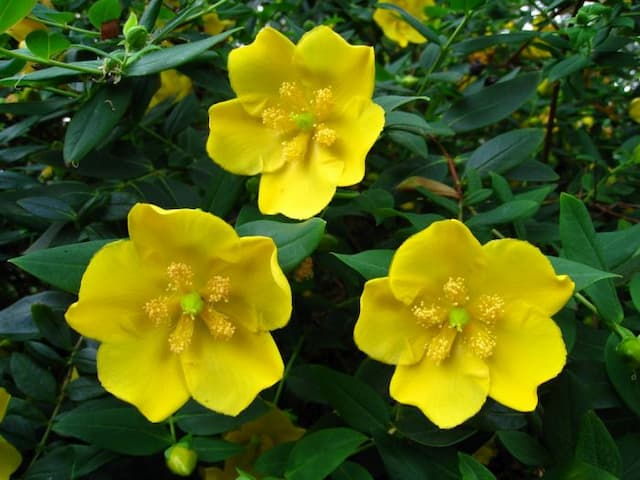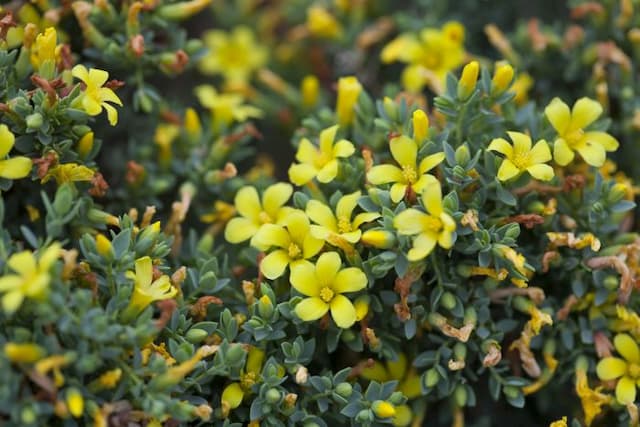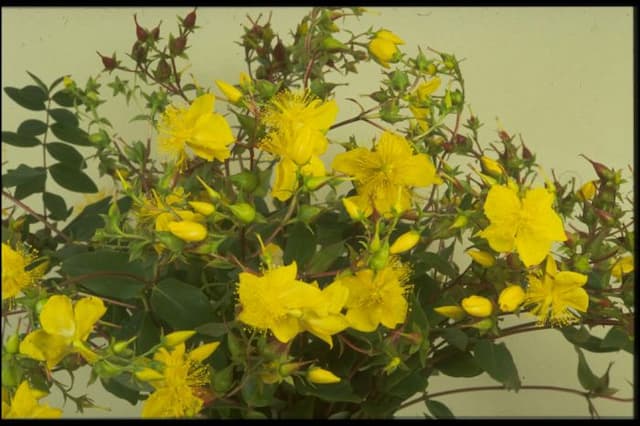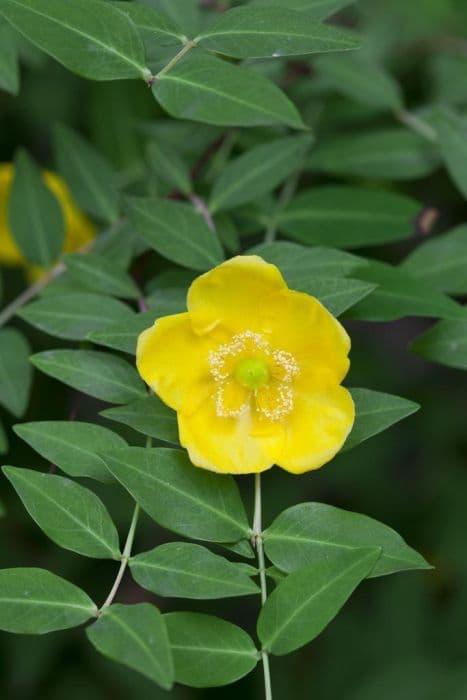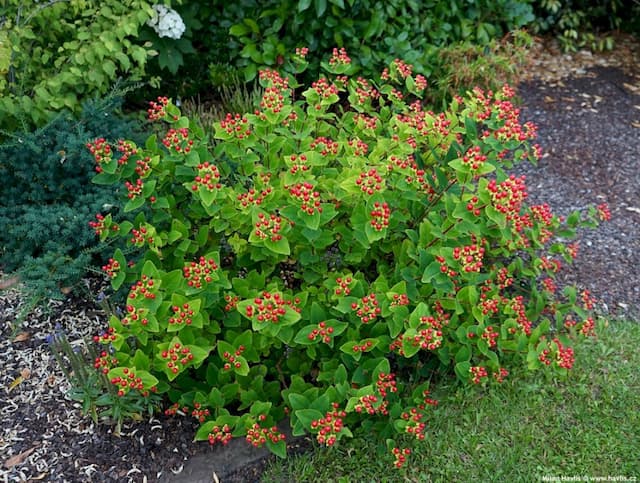St. John's Wort Hypericum 'Rowallane'

ABOUT
Hypericum 'Rowallane', commonly known as St John's Wort, is a deciduous shrub with a robust and bushy appearance. The plant sports abundant, glossy green leaves that have an elongated, oval shape and smooth, unblemished edges. The foliage provides a lush backdrop for the multitude of bright, golden-yellow flowers that bloom profusely in the summer. Each flower comprises numerous stamens that radiate from the center, giving a fluffy, almost fireworks-like appearance. These stamens surround prominent, central pistils. The attractive blooms often have a cupped or star-shaped form and are complemented by the presence of reddish-brown, berry-like fruits that appear after the flowering period. These fruits add further interest to the plant's appearance as they mature. The plant's overall presentation is one of vibrant greenery punctuated by bursts of sunny yellow, making it a striking addition to any garden space where it is grown.
About this plant
 Names
NamesFamily
Hypericaceae.
Synonyms
St. John's Wort, Rose of Sharon.
Common names
Hypericum 'Rowallane'.
 Toxicity
ToxicityTo humans
St. John's Wort, which includes Hypericum 'Rowallane', contains hypericin which can be toxic when ingested in large quantities. While considered safe in standard medicinal dosages for adults, over-consumption can lead to side effects such as confusion, dizziness, agitation, nausea, fatigue, and photosensitivity. Severe poisoning can result in organ damage but is rare. Care should be taken to avoid consuming large amounts of this plant.
To pets
St. John's Wort, which includes Hypericum 'Rowallane', is also toxic to pets. Ingesting this plant can cause similar symptoms as in humans, such as gastrointestinal upset, photosensitivity, and skin irritations. In pets, more severe reactions such as nerve damage or organ failure can occur if a significant amount is ingested. Pet owners should prevent animals from consuming this plant.
 Characteristics
CharacteristicsLife cycle
Perennials
Foliage type
Deciduous
Color of leaves
Green
Flower color
Yellow
Height
3-4 feet (0.9-1.2 meters)
Spread
3-4 feet (0.9-1.2 meters)
Plant type
Shrub
Hardiness zones
5
Native area
Cultivar
Benefits
 General Benefits
General Benefits- Attractive foliage: Hypericum 'Rowallane', commonly known as St. John's Wort, features distinctive foliage that adds texture and interest to the garden.
- Floral display: It produces bright yellow flowers that can enliven garden spaces and attract pollinators like bees and butterflies.
- Drought tolerance: Once established, St. John's Wort is known for its ability to withstand periods of drought, making it suitable for xeriscaping or low-water gardens.
- Easy propagation: The plant can be easily propagated from cuttings or seed, enabling gardeners to produce more plants economically.
- Low maintenance: St. John's Wort generally requires minimal care, making it a good choice for gardeners seeking low-maintenance landscaping options.
- Adaptable to various soil types: It is capable of growing in a wide range of soil conditions, from sandy to loamy soils, as long as there is adequate drainage.
- Seasonal interest: With its bright flowers in summer and berries in the autumn, St. John's Wort provides visual interest across multiple seasons.
- Supports Wildlife: The plant provides food for various species of wildlife, including birds that feed on its berries.
 Medical Properties
Medical PropertiesThis plant is not used for medical purposes.
 Air-purifying Qualities
Air-purifying QualitiesThis plant is not specifically known for air purifying qualities.
 Other Uses
Other Uses- The oil extracted from St. John's Wort can be used as a base for fragrant body oils, giving them a subtly earthy and warm scent.
- The vibrant yellow flowers are sometimes used as a natural dye, producing shades of yellow and orange on wool and other natural fibers.
- In traditional handcrafts, the plant's stems and flowers can be incorporated into potpourri mixes to add color and a mild, distinctive aroma.
- The blossoms, when dried, can be used in decorative flower arrangements and wreaths, especially for midsummer festivities.
- Gardeners may use the dense growth habit of St. John's Wort as a living mulch to suppress weeds around trees and shrubs.
- The flowers can attract a variety of pollinators, making the plant valuable for boosting the health of gardens and ecosystem diversity.
- In photography, branches of St. John's Wort can be used as a natural prop for outdoor shoots to add texture and rustic charm.
- The plant has been used ceremonially in some cultures during St. John's Day, symbolizing light and the triumph of good.
- In crafts, the bright yellow flowers can be used to decorate candles, creating an attractive, natural piece of home decor.
- St. John's Wort can be planted in outdoor pet areas as a non-toxic, pet-friendly plant that adds color without harming curious animals.
Interesting Facts
 Feng Shui
Feng ShuiSt. John's Wort is not used in Feng Shui practice.
 Zodiac Sign Compitability
Zodiac Sign CompitabilitySt. John's Wort is not used in astrology practice.
 Plant Symbolism
Plant Symbolism- Protection: Hypericum, commonly known as St. John's Wort, has been associated with warding off evil spirits and negative energies, symbolizing protection.
- Healing and Medicine: Due to its use in traditional medicine, particularly for its antidepressant properties, St. John's Wort represents healing and the power of nature to remedy ailments.
- Happiness and Positivity: The bright yellow flowers of St. John's Wort are often linked to buoyancy and cheerfulness, embodying light and positivity in one's life.
- Strength and Resilience: St. John's Wort's ability to thrive in poor soils and its hardy nature symbolize inner strength and the ability to overcome adversity.
 Water
WaterSt. John's wort requires regular watering to maintain moist but not waterlogged soil. During the growing season, water the plant once or twice a week, depending on weather conditions, using approximately 1 gallon of water each time for an established plant. Reduce the frequency of watering during the dormant season, typically in the fall and winter, ensuring that the plant receives water every two weeks, especially if there's insufficient rainfall. Always check soil moisture before watering; if the top inch of soil is dry, it's time to water.
 Light
LightSt. John's wort thrives in full sun to partial shade. Place it in a spot where it can receive at least six hours of direct sunlight daily. If grown indoors, ensure it's near a bright window with ample light. While it can tolerate some shade, too little light may result in fewer flowers and a less vigorous plant.
 Temperature
TemperatureSt. John's wort prefers temperatures between 60°F to 70°F but can survive in temperatures as low as 50°F and as high as 80°F. Avoid locations where winter temperatures drop below 50°F without protection, as the plant may not survive prolonged exposure to cold. The ideal temperature range ensures healthy growth and optimal flowering.
 Pruning
PruningPrune St. John's wort in early spring to remove any dead or damaged growth and promote bushier growth. Pruning may also be done after flowering to shape the plant and encourage a second bloom in the same season. Pruning is typically needed once a year, and the best time for major pruning is when the plant is dormant before new growth begins.
 Cleaning
CleaningAs needed
 Soil
SoilHypericum 'Rowallane', commonly known as St John's Wort, performs best in well-draining soil with a pH of around 5.5 to 7. A good soil mix for this plant would be one-third peat, one-third garden loam, and one-third sand or perlite to ensure proper drainage.
 Repotting
RepottingSt John's Wort should generally be repotted every 2 to 3 years to refresh the soil and facilitate continued growth. This timing can vary depending on the growth rate and conditions the plant is subjected to.
 Humidity & Misting
Humidity & MistingSt John's Wort thrives best in moderate humidity levels but is quite adaptable and can tolerate both low and high humidity levels without significant issues, as long as proper watering practices are followed.
 Suitable locations
Suitable locationsIndoor
Place in bright, indirect light and ensure good air circulation.
Outdoor
Plant in full sun to partial shade and in well-drained soil.
Hardiness zone
5-9 USDA
 Life cycle
Life cycleThe life cycle of Hypericum 'Rowallane', commonly known as St. John's Wort, begins with seed germination in suitable soil conditions, often in spring or early summer. The seedlings establish themselves quickly, developing a robust root system and foliage. As the plants mature, they enter the vegetative stage, producing characteristic green leaves and woody stems. During the flowering stage, typically from early summer to early fall, the plants produce bright yellow flowers with numerous stamens, attracting pollinators. Once pollinated, the flowers develop into capsules containing numerous tiny seeds. The plant eventually enters dormancy during the colder months, especially in regions with seasonal climates, but as a perennial, it re-emerges from its root system the following spring to repeat the cycle.
 Propogation
PropogationPropogation time
Spring-Early Summer
Hypericum 'Rowallane', commonly known as St. John's Wort, can be propagated by semi-hardwood cuttings during the summer. To do this, a healthy, disease-free branch is chosen and cuttings of about 4-6 inches (10-15 cm) long are made. These cuttings should include several leaf nodes, and the leaves on the lower half should be removed to expose the nodes. The cut end of the cutting is often dipped in rooting hormone powder to enhance root development and then inserted into a well-draining potting mix. The pot is then placed in a warm, bright area but out of direct sunlight, and the soil is kept consistently moist but not waterlogged. Covering the pot with a plastic bag can help retain humidity and improve the chances of successful rooting. After several weeks, once the cuttings have rooted, they can be potted up individually and grown on until they are ready for transplanting outdoors.
